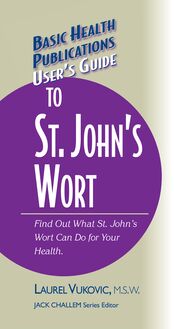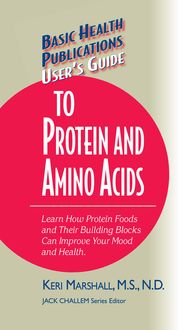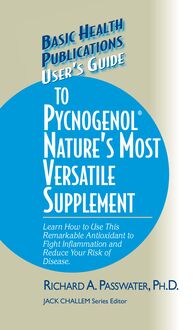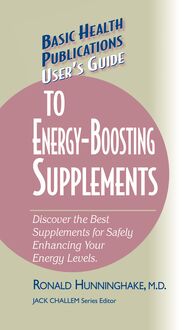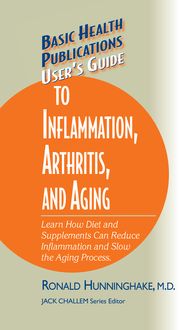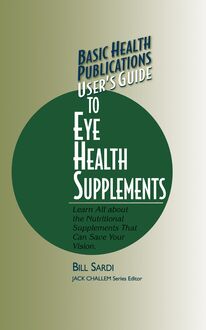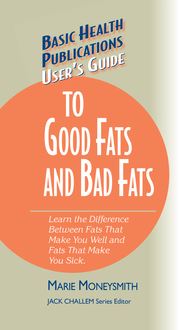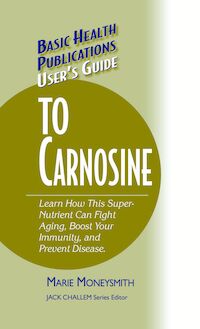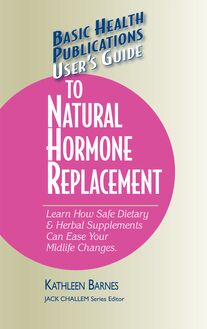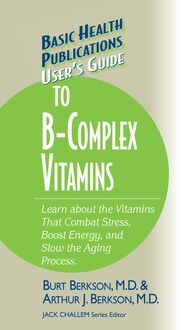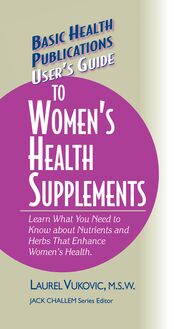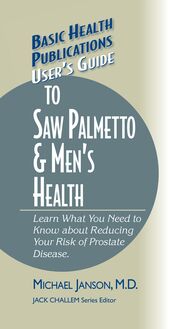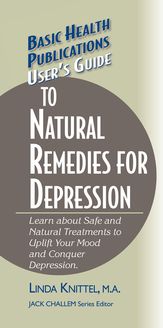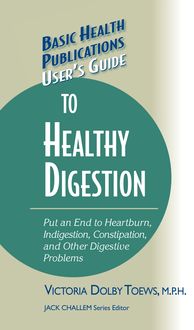User's Guide to Vitamins & Minerals , livre ebook
54
pages
English
Ebooks
2002
Vous pourrez modifier la taille du texte de cet ouvrage
Obtenez un accès à la bibliothèque pour le consulter en ligne En savoir plus
Découvre YouScribe en t'inscrivant gratuitement
Découvre YouScribe en t'inscrivant gratuitement
54
pages
English
Ebooks
2002
Vous pourrez modifier la taille du texte de cet ouvrage
Obtenez un accès à la bibliothèque pour le consulter en ligne En savoir plus
Publié par
Date de parution
01 janvier 2002
Nombre de lectures
0
EAN13
9781591206019
Langue
English
Poids de l'ouvrage
1 Mo
Written by leading experts and science writers, The User's Guide to Nutritional Supplements Series covers a range of popular alternative medicine and health issues, including specific major diseases, alternative therapies, and vitamins, minerals, herbs, and other nutritional supplements.
The User's Guide to Vitamins & Minerals explains how these remarkable nutrients can make a big difference in your health.
Publié par
Date de parution
01 janvier 2002
Nombre de lectures
0
EAN13
9781591206019
Langue
English
Poids de l'ouvrage
1 Mo
The information contained in this book is based upon the research and personal and professional experiences of the authors. It is not intended as a substitute for consulting with your physician or other health care provider. Any attempt to diagnose and treat an illness should be done under the direction of a health care professional.
The publisher does not advocate the use of any particular health care protocol but believes the information in this book should be available to the public. The publisher and author are not responsible for any adverse effects or consequences resulting from the use of the suggestions, preparations, or procedures discussed in this book. Should the reader have any questions concerning the appropriateness of any procedures or preparation mentioned, the author and the publisher strongly suggest consulting a professional health care advisor.
Series Editor: Jack Challem
Editor: Carol Rosenberg
Typesetter: Gary A. Rosenberg
Series Cover Designer: Mike Stromberg
Basic Health Publications User’s Guides are published by Basic Health Publications, Inc.
8200 Boulevard East
North Bergen, NJ 07047
1-800-575-8890
Copyright © 2002 by Jack Challem and Liz Brown
ISBN-13: 978-1-59120-601-9
ISBN-10: 1-59120-004-0
All rights reserved. No part of this publication may be reproduced, stored in a retrieval system, or transmitted, in any form or by any means, electronic, mechanical, photocopying, recording, or otherwise, without the prior written consent of the copyright owner.
Printed in the United States of America
10 9 8 7 6 5 4 3 2 1
C ONTENTS
Introduction
1. What Vitamins Can Do for Your Health
2. Vitamin A and the Carotenoids
3. The B-Vitamin Complex
4. Vitamin C
5. Vitamins D and K for Healthy Bones
6. Vitamin E for Heart and Mind
7. What Minerals Can Do for Your Health
8. Calcium, Magnesium, and Potassium for Healthy Heart and Bones
9. Reduce Your Cancer Risk with Selenium
10. Chromium Optimizes Insulin and Glucose Function
11. Zinc and Copper for Immunity
12. Iron, Iodine, and Manganese
13. Sulfur, Silicon, and Vanadium
14. How to Buy Quality Supplements
Selected References
Other Books and Resources
I NTRODUCTION
V itamins. They captivate. And, yes, they often do cure.
Few newspaper headlines grab a person’s attention faster than those describing the seemingly miraculous benefits of vitamins. Almost every week we hear reports that they can reverse heart disease, ease the aches and pains of arthritis, and reduce the risk of cancer.
Vitamins sound almost too good to be true. And you’re probably wondering if vitamins are as good as they’ve been cracked up to be.
The answer, in a nutshell, is a resounding “yes.” For years, doctors dismissed the value of vitamins, preferring to prescribe expensive drugs or to perform surgery. Now, each year, medical journals publish thousands of scientific articles describing the health benefits of vitamins, minerals, and other nutrients. And more doctors are recognizing the impressive health benefits of vitamins.
If you’re one of the six out of ten Americans who take vitamin supplements, this book will give you a better understanding of how they work to maintain and improve health. If you are thinking about taking vitamins, this book can help you decide what to take.
Vitamins are natural substances found in wholesome foods, and they have many advantages over drugs. They work in tandem with your body to promote health. They’re safe. They’re relatively inexpensive. They help keep you well. But with all the research and all the confusing headlines on vitamins, it’s also easy to be overwhelmed.
This User’s Guide to Vitamins and Minerals is meant to clear the confusion by providing simple, straightforward answers to your questions about vitamins and minerals. In the first chapter, you’ll learn some vitamin basics: why they are important to your health and why supplements are necessary even if you’re eating a healthy diet. The following chapters will describe the benefits of specific vitamins or family of vitamins, such as vitamin A; the B vitamins; and vitamins C, D, E, and K.
The second half of this book focuses on minerals, which are nutritionally related to vitamins. Minerals are just as important for health, and you’re probably already familiar with at least some of them, such as calcium. You’ll also learn about the health benefits of magnesium, chromium, selenium, and other minerals. Finally, the last chapter gives you important tips on how to buy and use vitamins and minerals.
Read on. Be well. And take your vitamins and minerals.
CHAPTER 1
W HAT V ITAMINS C AN D O FOR Y OUR H EALTH
Y our body requires relatively small amounts of vitamins compared with protein or carbohydrate. Still, many people do not obtain enough vitamins, either because they don’t eat the right foods or because of absorption problems.
Low levels of vitamins interfere with health, and many people go through life believing their health problems are a normal part of life or aging. When people take vitamin supplements for the first time, they often discover just how dramatically vitamins can improve health.
What Are Vitamins and Minerals?
If you ask a scientist, he or she will tell you that vitamins are organic compounds (containing at least one carbon atom) that promote virtually all biochemical processes in the body. This simple definition actually belies their powerful and diverse roles in health. For example, vitamin C is needed for the formation of skin and all other tissues, as well as for normal functioning of the immune system. Your body cannot make most vitamins, at least not in any substantial amount, so you have to get them from foods or supplements.
In contrast, minerals are elements, meaning that they cannot be broken down into simpler substances. However, minerals that have nutritional roles are found in the form of compounds, meaning they are combined with something else. Calcium citrate and chromium picolinate are examples of the many mineral compounds.
To keep things simple, think of vitamins and minerals as essential ingredients in a recipe—in this case, a recipe for your health. Basically, you need vitamins and minerals to grow, produce energy, fight disease, repair injured tissue, and maintain normal health. Recent scientific studies have even shown that many vitamins and minerals influence the behavior of genes in a positive way. You don’t need much of most vitamins and minerals compared with, let’s say, dietary protein or carbohydrate. Yet many people do not obtain adequate amounts of these important nutrients.
What do vitamins do?
Vitamins initiate and promote virtually all of the body’s biochemical activities needed for life and health.
The thirteen essential vitamins are divided into two groups. One group consists of water-soluble vitamins that need to be replenished daily because they are rapidly excreted. These vitamins include vitamin C and the B-complex family of vitamins.
The second group consists of fat-soluble vitamins, which the body is capable of storing for weeks or months. The fat-soluble vitamins are vitamins A, D, E, and K.
There are also many vitaminlike nutrients that are not officially recognized as vitamins, though their functions are similar. Coenzyme Q 10 , alpha-lipoic acid, beta-carotene and other carotenoids, and quercetin and other flavonoids are among these vitaminlike nutrients.
You’ll learn more about minerals in Chapters 7 through 14 .
Vitamins Can Do a Lot for You
Whether you’re young or old, male or female, work hard physically or have a desk job, vitamin supplements can often have an amazing effect on your health.
First and foremost, vitamins are essential nutrients that help your body function normally. They can help reduce your risk of developing many serious diseases, such as heart disease, cancer, Alzheimer’s disease, and arthritis.
Secondly, many doctors also use vitamins to treat diseases. For example, several large studies with people (not laboratory rats, mind you) have found that vitamin E supplements dramatically reduced the risk of coronary heart disease. Other studies have found that vitamin C reduces symptoms of the common cold and flu by one-third—basically meaning that the vitamin cuts down your sick time by a couple of days.
Still other studies have found that high intake of vitamins reduce the risk of diabetes, arthritis, and many different types of cancer. It practically goes without saying that most people prefer to be healthy than to be sick and miserable. Vitamins can keep you healthy.
One of the most amazing things that happens with vitamin supplementation is what some nutritionally oriented physicians call “side benefits.” The term is in sharp contrast to drugs, which tend to have side effects. These doctors have found over and over again that a vitamin supplement prescribed for one condition, such as arthritis, produces unexpected benefits, such as improvements in sleep or mood.
Vitamins Often Reverse Health Problems
Many people who start taking vitamin supplements quickly discover that they can correct and reverse long-standing health problems. For example, British researchers recently gave natural vitamin E supplements (400–800 IU/day) to men and women who had suffered a heart attack. After an average of eighteen months, people getting vitamin E had 77 percent fewer heart attacks than those given a dummy pill.
IU, mg, and mcg
Each is a measurement of vitamins by potency or weight. All three are extremely small amounts. For example, 400 mcg is about 1/70,000 of an ounce.
Here’s another example: Abram Hoffer, M.D., Ph.D., of Victoria, Canada, has been treating terminal cancer patients with a high-potency vitamin/mineral regimen. He started doing this years ago to treat their depression and anxiety related to the cancer diagnosis. Hoffer has found that 30 percent of his early cancer patients (that is, long-term u
